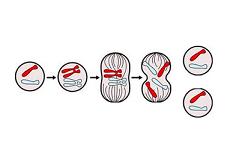 The set of stages developed between two cell divisions that take place consecutively is called the cell cycle . The process begins when a new cell arises, descending from another that divided, and ends when that cell undergoes the next division and gives rise to another pair, which are considered its daughters.
The set of stages developed between two cell divisions that take place consecutively is called the cell cycle . The process begins when a new cell arises, descending from another that divided, and ends when that cell undergoes the next division and gives rise to another pair, which are considered its daughters.
The cell cycle can be understood as a series of events that occur in an orderly manner as a cell grows and eventually divides into two daughter cells . Cells go through two states : interphase (non-dividing state) and M phase (dividing state).
In interphase, the cell performs certain specific functions as it progresses toward cell division . The initial stage is known as Phase G1 , when it begins to synthesize RNA and proteins . In this phase the cell manages to double its mass and size. Then comes the S Phase with the synthesis of DNA and the duplication of each chromosome.
The cell cycle continues with the G2 Phase of the interphase: the synthesis of RNA and proteins continues and division begins. In this instance the cell enters the second state, called Phase M.
This M Phase is when the cell division takes place: the progenitor cell divides into two other cells (the daughter cells), which are identical. Phase M includes mitosis and cytokinesis .
Mitosis is a biological process that takes place in the nucleus of a eukaryotic cell , just before it divides; In short, it consists of the characteristic hereditary material being distributed equitably. Cytokinesis , for its part, is the physical division of the cytoplasm into two cells.
Cell cycle regulation
 In 2001, an explanation for the regulation of the cell cycle was disseminated, which can be observed in eukaryotic organisms from the point of view of the decisions that are made at certain critical moments of the cycle itself, in particular mitosis. From this some questions arise, such as why DNA is replicated only once or why it is possible for cellular euploidy to be maintained .
In 2001, an explanation for the regulation of the cell cycle was disseminated, which can be observed in eukaryotic organisms from the point of view of the decisions that are made at certain critical moments of the cycle itself, in particular mitosis. From this some questions arise, such as why DNA is replicated only once or why it is possible for cellular euploidy to be maintained .
The answer may be found in the fact that during the G1 phase, cyclin facilitates the addition of regulators called Cdc6 to the origin recognition complex ( ORC ), which is responsible for requesting the action of the genetic replication machinery in the midst of a process in which a complex is generated for future DNA replication .
When the beginning of the S phase arrives, Cdk-S generates Cdc6 dissociation and degrades its proteins, in addition to exporting Mcm to the cytosol, so that until the next cycle it is not possible for the origin of replication to recruit a prereplicative complex. Throughout the G2 and M phase, the uniqueness of this structure is maintained until the level of Cdk activity declines after mitosis and it is again possible to add Mdm and Cdc6 for the next cycle.
Another question raised by this study is how mitosis is entered . To answer it, we can think that cyclin B, common in Cdk-M, is present throughout the cycle. Cyclin is usually inhibited by phosphorylation by the protein called Wee ; However, when the G2 phase is about to conclude, a phosphate called Cdc25 is activated and eliminates the inhibitory phosphate so that its activity increases. It also activates Cdk-M and inhibits Wee, thereby causing a positive feedback that results in Cdk-M accumulation.
